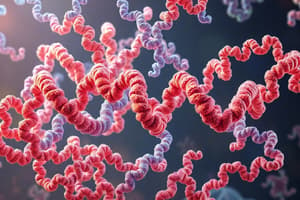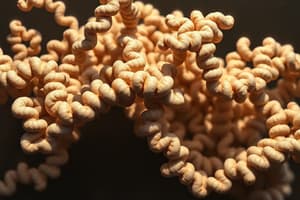Podcast
Questions and Answers
What primarily drives hydrophobic residues to the interior of a cytosolic protein?
What primarily drives hydrophobic residues to the interior of a cytosolic protein?
- Hydrogen bonding with water (correct)
- Electrostatic interactions
- Interactions with the membrane lipids
- Hydrophobic interactions with the fatty acids
How does the flexibility of proteins contribute to their function?
How does the flexibility of proteins contribute to their function?
- It allows proteins to transition between different conformations. (correct)
- It prevents proteins from interacting with other molecules.
- It makes proteins more rigid and stable.
- It isolates proteins from their surrounding environment.
Which of the following statements about protein structure is true?
Which of the following statements about protein structure is true?
- Proteins do not change their three-dimensional structure once synthesized.
- All proteins are rigid and do not fluctuate.
- Hydrogen bonds are irrelevant to the protein folding process.
- The amino acid sequence determines both the structure and function of the protein. (correct)
What influences the folding of membrane proteins the most?
What influences the folding of membrane proteins the most?
What role do solvent interactions play in protein folding?
What role do solvent interactions play in protein folding?
Flashcards
Protein Flexibility
Protein Flexibility
Proteins are not rigid structures; they are flexible and constantly moving, adjusting their three-dimensional structure due to atomic movement.
Protein Folding
Protein Folding
The amino acid sequence of a protein determines its three-dimensional structure and function.
Solvent Influence on Protein Folding
Solvent Influence on Protein Folding
Water molecules interact with proteins, causing hydrophobic residues to move to the interior of the protein and hydrophilic residues to face the surface.
Membrane Protein Folding
Membrane Protein Folding
Signup and view all the flashcards
Molecular Modeling of Proteins
Molecular Modeling of Proteins
Signup and view all the flashcards
Study Notes
Protein Folding
- Protein amino acid sequence dictates shape and function.
- Proteins are flexible molecules, constantly fluctuating.
- Each protein atom moves up to 0.1 Å in any direction, causing constant structural adjustment.
- This flexibility is crucial for function and folding transitions.
Protein Folding and Solvents
- Cellular proteins interact with solvents, influencing folding.
- Cytosolic proteins interact with water.
- Water forms hydrogen bonds with surface N and O atoms.
- Hydrophobic amino acids cluster in the protein interior due to water's influence.
- Membrane proteins have different solvent interactions.
- Membrane proteins are surrounded by hydrophobic fatty acids and polar membrane lipids & water.
- Molecular modeling can show critical solvent impacts on protein structure and folding.
Studying That Suits You
Use AI to generate personalized quizzes and flashcards to suit your learning preferences.




